|
CHAPTER ONE
THE WARS OF MAN
"In the spring of 1947, a shepherd boy searching for a lost sheep in
the barren cliffs overlooking the Dead Sea, discovered a cave that
contained Hebrew scrolls - had lain undisturbed for nearly two
thousand years, carefully wrapped and hidden away during the
turbulent years when Judea challenged the might of the Roman empire.
"....One of the longest and most complete scrolls, and perhaps the
most dramatic, deals with a future war, a kind of Final War. Titled
by scholars The Wars of the Sons of Light Against the Sons of
Darkness, it envisages spreading warfare - local battles that will
first involve Judea’s immediate neighbors, which shall increase in
ferocity and scope until the whole ancient world would be engulfed:
"The first engagement of the
Sons of Light against the Sons of
Darkness, that is against the army of Belial, shall be an attack
upon the troops of Edom, Moab, the Ammonites and the
Philistine
area; then upon that of the Kittians of Assyria; and upon those
violators of the Covenant who give them aid...."
And after those
battles, "they shall advance upon the Kittians of
Egypt" and "in due
time.... against the kings of the north."
"In this
War of Men, the scroll prophesied, the God of Israel shall
take an active roll:
"On the day the Kittians fall, there shall be mighty combat and
carnage, in the presence of the God of Israel;
For that is the day which he appointed of old for the final battle
against the Sons of Darkness.
Of this battle, (and going further than the Prophet
Ezequiel) the
Dead Sea Scroll says:
"On that day, the Company of the Divine and the Congregation of the
Mortals shall engage side by side in combat and carnage.
The Sons of Light shall battle against the Sons of Darkness with a
show of godlike might, amid uproarious tumult, amid the war cries of
gods and men." "
"....One of the most romanticized wars, when "love had launched a
thousand ships," was the War of Troy, between the
Achaean Greeks and
the Trojans. It was, know we not, launched by the Greeks to force
the Trojans to return the beautiful Helen to her lawful spouse. Yet
an epic Greek tale, the Kypria, represented the war as a
premeditated scheme by the great god Zeus:
There was a time when thousands upon thousands of men encumbered the
broad bosom of the Earth, and having pity on them, Zeus in his great
wisdom resolved to lighten Earth’s burden.
So he caused the strife of Ilion (Troy) to that end; that through
death he might make a void in the race of men.
Mr. Sitchin explains more in his book, about the
reasonings of the
gods, and the interference of the demi-god Achilles, which caused
the decision for Jove (Jupiter/Zeus) to take action.
Mr. Sitchin continues:
"....The Battle of Troy, indeed Troy itself, was long thought of as
just part of the fascinating but incredible Greek legends, which
scholars have tolerantly called mythology. Troy and the events
pertaining to it were still considered to be pure mythological when
Charles McLaren suggested, back in 1822, that a certain mound in
eastern Turkey, called Hissarlik, was the site of the
Homeric Troy.
It was only when a businessman named Heinrich Schliemann, risking
his own money, came up with spectacular discoveries as he dug up the
mound in 1870, that scholars began to acknowledge the existence of
Troy. It is now accepted that the Battle of Troy had actually taken
place in the thirteenth century B.C. It was then, according to the
Greek sources, that gods and men had fought side by side; in such
beliefs the Greeks were not alone.
"For centuries prior to the war of Troy,
the Hittites expanded their
kingdom to imperial proportions, claiming to have done so upon the
orders of their supreme god TESHUB ("The Stormer"). His olden title was "Storm God Whose Strength Makes Dead," and
Hittite kings sometimes claimed that the god had actually taken a
hand in the battle.... Also aiding the Hittites in the battle was
the goddess ISHTAR, whose epithet was "Lady of the battlefield."
"....Hittite influence, as many references in the
Old Testament
indicate, extended south into Canaan; but they were there as
settlers, not as conquerors. While they treated Canaan as a neutral
zone, laying to it no claim, this was not the attitude of the
Egyptians. Repeatedly the Pharaohs sought to extend their rule
northward to Canaan and the Cedar Land (Lebanon); they succeeded in
doing so, circa 1470 B.C., when they defeated a coalition of
Canaanite kings at Megiddo.
"....the Hittite’s own inscriptions suggest that
they went to war
only when the gods gave the word, that the enemy was offered a
chance to surrender peacefully before hostilities began, and that
once a war was won, the Hittites were satisfied to receive tribute
and take captives: the cities were not sacked; the populace was not
massacred.
"....The vicious nature of Egyptian warfare and the pitiless
destructiveness they inflicted upon a vanquished foe were subjects
of boastful inscriptions. The Pharaoh Pepi I, for example,
commemorated his victory over the Asiatic "sand-dwellers" in a poem
which hailed the army which "hacked up the land of the
sand-dwellers... cut down its fig trees and vines... cast fire into
all its dwellings, killed its people by many tens of thousands." The
commemorative inscriptions were accompanied by vivid depictions of
the battle scenes.
The Pharaoh Pi-Ankhy adhered to this wanton tradition.
"The god Amon, to whose battle orders the
Egyptians attributed their
viciousness, found his match in the God of Israel. In the words of
the Prophet Jeremiah,
"Thus sayeth the Lord of Hosts, the God of
Israel: ’I will punish Amon, god of Thebes, and those who trust in
him, and shall bring retribution upon Egypt and its gods, its
Pharaohs and its kings.’"
This we learn from the Bible, was an
ongoing confrontation; nearly a thousand years earlier, in the days
of the Exodus, Yahweh, the God of Israel smote Egypt with a series
of afflictions intended not only to soften the heart of its ruler
but also as "judgments against all the gods of Egypt."
"....The biblical language is almost identical to the words of a
later Pharaoh, Ramses II, used by him to describe the miraculous
appearance of Amon-Ra at his side during a decisive battle fought
with the Hittites in 1286 B.C.
".... The
Hittite victory might have been more decisive, for they
had almost captured the Pharaoh himself.... Ramses, on his return to
Egypt saw fit to describe in detail the miracle of his escape:
"....As Ramses went on pleading with his god
Amon to save him, for
the god’s powers were greater than those of "millions of foot
soldiers, of hundreds of thousands of chariot-soldiers," a miracle
happened: the god showed up on the battlefield!
"....Thus unopposed , slaying the enemy left and right,
Ramses
managed to escape.
"After the death of
Muwatallis, (Hittite king) Egypt and the
Hittite
kingdom signed a peace treaty, and the reigning Pharaoh took a
Hittite princess to be his principal wife. The peace was needed
because not only the Hittites but also the Egyptians were
increasingly coming under attack by "Peoples of the Sea" - invaders
from Crete and other Greek islands. They gained a foothold on the
Mediterranean coast of Canaan to become the biblical
Philistines;
but their attacks on Egypt proper were beaten back by the
Pharaoh Ramses III, who commemorated the battle scenes on temple walls. He
attributed his victories to his strict adherence to "the plans of
the All-Lord, my august divine father, the Lord of the Gods." It was
to his god Amon-Ra, Ramses wrote, that the credit for the victories
was due: for it was:
"Amon-Ra who was after them, destroying them."
|
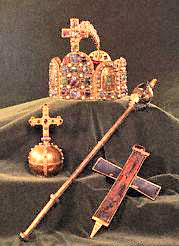
Regalia from
the Holy Roman Empire |
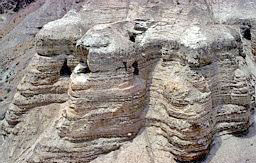
Caves of
Essene Community, Qumran, by the Dead Sea where in 1947
the Scrolls were found
.
|
|
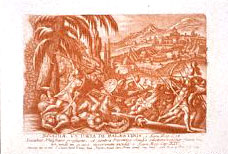
A Biblical
scene of the Men of Judah against Philistines
|
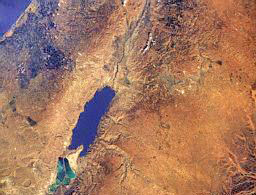
Dead Sea
from Space |
|
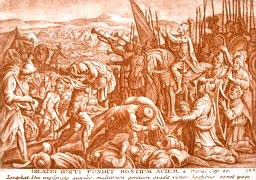
A Biblical
scene of the Men of Judah against Moabites, and
Ammonites
|
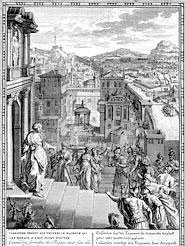
Trojans
being warned of their fate |
|
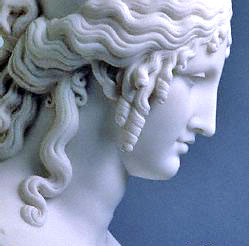 |
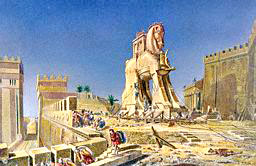
Above - Culmination
of the Trojan War
Left -
Helen, the given reason for the Trojan War, the Greeks
demanded the return of Helen to her devouted spouse....
but, it was the god Zeus who plotted.... in the Wars of
Gods and Men....
|
|
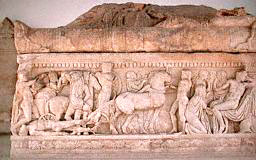
A scene from
the Illiad, where the King of Troy begs Achilles to
return the body of Hector |
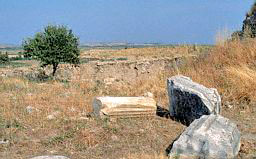
Ruins of
Troy I and Troy II, Turkey today
.
|
|
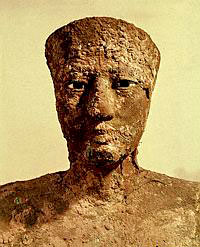
Pepi I
claimed barbarous victory over the Asians
|
|
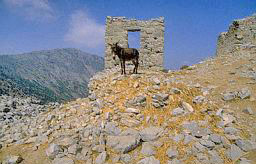
The peoples
of Crete, above; and Greek Islands became the
Philistines, right. |

. |
|
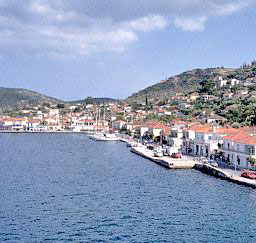
Greek
Islands became the Philistines |
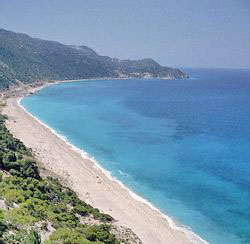
Greek
Islands became the Philistines |
|
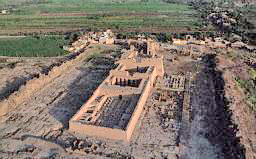
Temple of
Ramses III. He was victorious over the Philistines.
|
"The bloody trail of
man’s war against his fellow man in behalf of the gods now takes us
back to Mesopotamia - the Land between the Rivers (Euphrates and
Tigris) - the biblical Land of Shin’ar. There, as is related in
Genesis 11, the first-ever cities arose, with buildings made with
bricks and towers that scraped the skies. It was there that recorded
history began; it was there that prehistory began with the
settlements of the Olden Gods.
"It is a tale of long ago, which we will soon unfold. But right now
let us return to a thousand years before the traumatic times of
Ramses II in Egypt. Then, in faraway Mesopotamia, kingship was taken
over by an ambitious young man. He was called Sharru-Kin -
"Righteous Ruler"; our textbooks call him Sargon
the First. He built
a new capital city, calling it Agade, and established the kingdom of Akkad. The
Akkadian language, written in wedge-like (cuneiform)
script, was the mother tongue of all the Semitic languages, of which
Hebrew and Arabic are still in use.
"Reigning for the better part of the twenty-fourth century B.C.,
Sargon attributed his long reign (fifty-four years) to the special
status granted him by the Great Gods, who made him "Overseer of
Ishtar, Annointed Priest of ANU, Great Righteous Shepherd of
ENLIL." It was Enlil, Sargon wrote, "who did not let anybody oppose
Sargon" and who gave Sargon "the region from the Upper Sea to the
Lower Sea" (from the Mediterranean to the Persian Gulf). It was
therefore to "the gate of the House of Enlil" that
Sargon brought
the captive kings, ropes tied to the dog collars around their necks.
"....The Akkadian dynasty begun by Sargon reached its peak under his
grandson Naram-Sin ("Whom the god Sin loves"). His conquests,
Naram-Sin
wrote on his monuments, were possible because his god had armed him
with a unique weapon, the "Weapon of the God," and because the other
gods granted him their explicit consent - or even invited him - to
enter their regions.
"....Just as Naram-Sin could attribute his successful campaigns to
his heeding the command of his gods, so was his downfall attributed
to his going to war against the word of the gods. Scholars have put
together from fragments of several versions a text that has been
titled The Legend of Naram-Sin. Speaking in the first person,
Naram-Sin
explains in this tale of woe that his troubles began when the
goddess Ishtar, "changed her plan" and the gods gave their blessing
to "seven kings, brothers, glorious and noble; their troops numbered
360,000...." and they were threatening Akkad itself. Naram-Sin asked
the gods what to do and was told to put aside his weapons and,
instead of going to battle, to go sleep with his wife (but, for some
deep reason, avoid making love).
"....But Naram-Sin, announcing that he would rely on his own
weapons, decided to attack the enemy in spite of the god’s advice.
"....On the fourth anniversary of the unauthorized war,
Naram-Sin
appealed to the great god Ea to overrule Ishtar and put his case
before the other gods. They advised him to desist from further
fighting, promising that "in days to come, Enlil will summon
perdition upon the "Sons of Evil," and Akkad would have respite.
"The promised era of peace lasted about three centuries, during
which the olden part of Mesopotamia, Sumer, reemerged as the
center
of kingship, and the oldest urban centers of the ancient world -
Ur, Nippur, Lagash,
Isin, Larsa - flourished again. Sumer, under the
kings of Ur, was the center of an empire that encompassed the whole
of the ancient Near East. But toward the end of the third millennium
B.C., the land became the arena for contending loyalties and
opposing armies, and then that great civilization - succumbed to a
major catastrophe of unprecedented proportions.... It was those
Mesopotamian texts stated, a catastrophe that befell Sumer as a
result of a decision of the great gods sitting in council.
"It took
Mesopotamia almost a century to be resettled and another
century to fully recover from the divine annihilation. By then, the
center of Mesopotamian power had shifted northward, to Babylon.
There, a new empire was to rise, proclaiming an ambitious god, MARDUK, as its supreme deity.
"Circa 1800 B.C.,
Hammurabi, the king renowned for his law code,
ascended the throne in Babylon and began to extend his boundaries.
According to his inscriptions the gods not only told him if and when
to launch his military campaigns but were literally leading his
armies....
"....But before long Babylon had to share its might with a new rival
to its north - Assyria, where not Marduk but the bearded god
ASHUR
("The All-Seeing") was proclaimed supreme. While Babylon tangled
with the lands to its south and east, the Assyrians extended their
rule northward and westward, as far as "the country of Lebanon, on
the shores of the Great Sea." These were lands in the domains of the
gods NINURTA and ADAD, and the Assyrian kings carefully noted that
they launched their campaigns on the explicit commands of these
great gods.
"....In assuming the title "king of the world, king of the four
regions of the Earth," the Assyrian kings directly challenged
Babylon, for Babylon encompassed the ancient region of Sumer and
Akkad. To legitimize their claim the Assyrian kings had to take
control of those olden cities where the Great Gods had their homes
in olden times; but the way to these sites was blocked by Babylon.
The feat was achieved in the ninth century B.C. by Shalmaneser
III....
"....Describing his various military campaigns,
Shalmaneser asserted
that his victories were achieved with weapons provided by two gods:
"I fought with the Mighty Force which
Ashur, my lord, had given me,
and with the strong weapons which Nergal, my leader, had presented
to me."
The weapon of Ashur was described as having a "terrifying
brilliance." In a war with Adini the enemy fled on seeing "the
terrifying Brilliance of Ashur; it overwhelmed them."
"When
Babylon, after several acts of defiance, was sacked by the
Assyrian king Sennacherib (in 689 B.C.), its demise was made
possible because its own god, Marduk, became angry with its king and
people, and decreed that "seventy years shall be the measure of its
desolation" - exactly as the God of Israel had later decreed for
Jerusalem. With the subjugation of the whole of Mesopotamia,
Sennacherib was able to assume the cherished title "King of Sumer
and Akkad...." He conquered.... with the aid of "the awe-inspiring
Brilliance, the weapon of Ashur, my lord." Reliefs that illustrate
his campaigns (as the one depicting the siege of Lachish), show the
attackers using rocketlike missiles against their enemy. In the
conquered cities Sennacherib "killed their officials and patricians
... and hung their bodies on poles surrounding the city; the common
citizens I considered prisoners of war."
"An artifact known as the
Prism of Sennacherib preserved an
historical inscription in which he made mention of the subjugation
of Judea and his attack to Jerusalem. The quarrel
Sennacherib had
with its king, Hezekiah, was the fact that he held Padi, the king of
the Philistine city of Ekron, "who was loyal to his solemn oath to
his god Ashur."
"....The siege of Jerusalem offers several interesting aspects. It
had no direct cause but only an indirect one: the forced holding
there of the loyal king of Ekron. The "awe-inspiring Brilliance, the
weapon of Ashur," which was employed to "overwhelm the strong
cities" of Phoenicia and Philistia, was not used against
Jerusalem.
And the customary inscriptional ending "I fought with them and
inflicted defeat upon them" is missing in the case of Jerusalem;
Sennacherib merely reduced the size of Judea by giving its outlying
areas to neighbouring kings.
"More over, the usual claim that a land or a city was attacked upon
the "trustworthy orders" of the god Ashur was also absent in the
case of Jerusalem; one wonders whether all this meant that the
attack on the city was an unauthorized attack - a whim of
Sennacherib himself but not the wish of his god?
"This intriguing possibility becomes a convincing probability as we
read the other side of the story - for such another side does exist
in the Old Testament."
The story is told in II Kings, Chapters 18 and 19. In fact, one of
Sennacherib’s generals bluff in front of the people of Jerusalem, in
the Hebrew language so that all could understand. He pretended
Yahweh had commanded him to fight against Jerusalem. The bluff was
found and king Hezekiah was informed through the Prophet Isaiah
that:
"’Concerning the king of Assyria ... the way that he came, he shall
return; and unto this city he shall not come in ... for I shall
defend this city to save it.’"
And it came to pass that night,
that the Angel of Yahweh went forth
and smote in the camp of the Assyrians
a hundred and eighty-five thousand;
and at sunrise, lo and behold,
they were all dead corpses.
So Sennacherib, the king of Assyria,
departed, and journeyed back and dwelt in Nineveh.
Sennacherib was
assassinated by his sons Adrammelech and Sharezzer.... "And
Esarhaddon, his son, reigned in his stead."
An inscription of Esarhaddon known as Prism B describes:
"....On the command of the great gods,
Sennacherib had publicly
proclaimed his younger son as successor. "He called together the
people of Assyria, young and old, and he made my brothers, the male
offspring of my father, take a solemn oath.... in order to secure my
succession." The brothers then broke the oath, killing Sennacherib
and seeking to kill Esarhaddon. But the gods snatched him away "and
made me stay in a hiding place.... preserving me for kingship."
"After a period of turmoil Esarhaddon received "a trustworthy
command from the gods: ’Go, do not delay! We will march with you!’"
"The deity who was delegated to accompany Esarhaddon was
Ishtar. As
his brother’s forces came out of Nineveh to beat off his attack on
the capital, "Ishtar, The Lady of Battle, who wished me to be her
high priest, stood at my side. She broke their bows, scattered their
orderly battle array." Once the Ninevite troops were disorganized,
Ishtar addressed them in behalf of Esarhaddon. "Upon her lofty
command, they went over in masses to me and rallied behind me,"
Esarhaddon wrote, "and recognized me as their king."
"Both Esarhaddon and his son and successor Ashurbanipal attempted to
advance against Egypt and both employed Weapons of Brilliance in the
battles.
"....Other inscriptions of Ashurbanipal suggest that this weapon,
which emitted an intense, blinding brightness, was worn by the gods
as part of their headgear. In one instance an enemy "was blinded by
the brightness from the god-head." In another, "Ishtar, who dwells
in Arbela, clad in Divine Fire and sporting the
Radiant Headwear,
rained flames upon Arabia."
"The Old Testament, too, refers to such a
Weapon of Brilliance that
could blind. When the Angels (literally, emissaries) of the
Lord
came to Sodom prior to its destruction, the populace attempted to
break down the door of the house in which they were resting. So the
Angels "smote the people at the entrance of the house with
blindness.... and they were unable to find the doorway."
"....The biblical prophecies predicting the downfall of Assyria
indeed came true.... The disintegration of the Assyrian empire was
seized by vassal kings in Egypt and Babylonia as an opportunity to
attempt the restoration of their own hegemonies. The lands between
them were once again the cherished prize, and the Egyptians, under
the Pharaoh Necho, were quicker in invading these territories.
"In Babylonia, Nebuchadnezzar II - as recorded in his inscriptions -
was ordered by the god Marduk to march his army westward. The
expedition was made possible because "another god," the one who held
the original sovereignty over the area, "has not desired the cedar
land" anymore; and now "a foreign enemy was ruling and robbing it."
"In Jerusalem the word of the Lord
Yahweh through his prophet
Jeremiah was to side with Babylon, for the Lord Yahweh - calling
Nebuchadnezzar "my servant" had decided to make the Babylonian king
the instrument of his wrath against the gods of Egypt:
Thus sayeth Yahweh, Lord of Hosts, The God of Israel:
"Indeed will I send for and fetch Nebuchadnezzar, my servant ...
and he shall smite the land of Egypt,
and deliver such as are for death to death,
and such as are for captivity to captivity,
and such as are for the sword to the sword.
And I will kindle a fire in the house of Egypt’s gods, and he will
burn them ...
And he will break the obelisks of Heliopolis,
the one which is in the land of Egypt;
The houses of the gods of Egypt shall he burn with fire."
"In the course of this campaign the Lord
Yahweh announced that
Jerusalem, too, shall be punished on account of its people’s sins,
having taken up the worship of the "Queen of Heaven" and of the
gods
of Egypt:
"Mine anger and my fury shall be poured upon this place
... and it shall burn and shall not be quenched ... In the city on
which my name has been called, the doom will I begin."
And so it was
that in the year 586 B.C. "Nebuzaraddan, captain of the guard of the
king of Babylon, came into Jerusalem, and he burned the
House of
Yahweh, and the king’s house, and all the houses of Jerusalem ...
and all the walls around Jerusalem were torn down by the armies of
the Chaldeans." This desolation, Yahweh promised, however, would last
only seventy years.
"The king who was to fulfill this promise and enable the rebuilding
of the Temple of Jerusalem was Cyrus. His ancestors, speaking an
Indo-European language, are believed to have migrated south from the
Caspian Sea area to the province of Anshan along the eastern coast
of the Persian Gulf. There Hakham-Anish ("Wise Man"), the leader of
the migrants, began a dynasty we call Achaemenid; his descendants -
Cyrus, Darius, Xerxes - made history as rulers of what was to be the
Persian empire.
"....Cyrus left his successors an empire that encompassed all the
earlier empires and kingdoms but one. Sumer, Akkad,
Babylon, and
Assyria in Mesopotamia; Elam and
Media to the east; the lands of the
north; the Hittite and Greek lands in Asia Minor;
Phoenicia and
Canaan and Philistia - all had come now under one sovereign king and
one supreme god, Ahura-Mazda, god of Truth and Light. He was
depicted in ancient Persia as a bearded deity roaming the skies
within a Winged Disk - very much in the manner in which the
Assyrians had depicted their supreme god, Ashur.
"When
Cyrus died in 529 B.C., the only remaining independent land
with its independent gods was Egypt. Four years later his son and
successor, Cambyses, led his troops along the Mediterranean coast of
the Sinai peninsula and defeated the Egyptians at Pelusium; a few
months later he entered Memphis, the Egyptian royal capital, and
proclaimed himself a Pharaoh.
Cambyses recognized
Egypt did not come under his god Ahura-Mazda,
therefore:
"In deference to the
independent gods of Egypt, Cambyses prostrated
himself before their statues, accepting their dominion. In return
the Egyptian priests legitimized his rule over Egypt by granting him
the title "Offspring of Ra."
"The ancient world was now united under one king,
chosen by the
"great god of truth and light" and accepted by the gods of Egypt.
Neither men nor gods had cause left to war with each other. Peace on
Earth!
"But peace failed to last. Across the Mediterranean Sea, the
Greeks
were increasing in wealth, power, and ambitions. Asia Minor, the
Aegean Sea, and the eastern Mediterranean saw increasing clashes,
both local and international. In 490 B.C., Darius I attempted to
invade Greece and was defeated at Marathon; nine years later
Xerxes
I was defeated at Salamis. A century and a half later
Alexander of
Macedonia crossed over from Europe to launch a campaign of conquest
that saw the blood of men flow in all the ancient lands as far as
India.
"Was he carrying a "trustworthy command"
of the gods? On the
contrary. Believing a legend that he was fathered by an Egyptian
god, Alexander at first fought his way to Egypt to hear the god’s
oracle confirm his semidivine origins. But the oracle also predicted
his early death, and Alexander’s travels and conquests were
thereafter motivated by a search for the Waters of Life, so that he
might drink of them and evade his fate.
"He died, in spite of all the carnage, young and in his prime. And
ever since, the Wars of Men have been the wars of men alone."
|
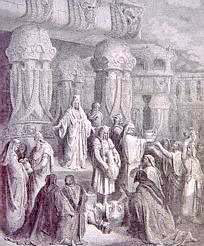
One of the
cities fallen in The Wars of Gods and Men was Jerusalem,
captive of Nebuchadnezzar. Restored by King Cyrus of
Persia, he rebuilt the Temple of Yahweh.
|
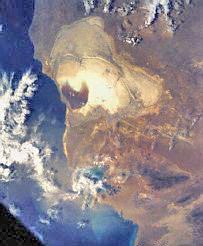
Caspian Sea
area view from space
. |
|

Cyrus
parents came from the Caspian Sea area and moved to the
area of the Persian Gulf
. |
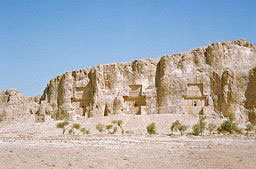
Cyrus
parents established the Achaemenid Dynasty. Tombs of the
Kings, above. Offerings, below. |
|
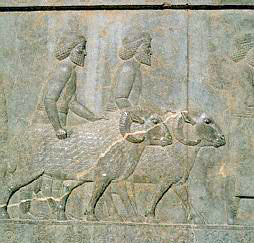 |
|
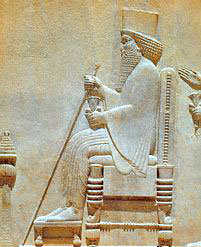 |
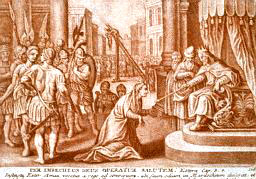
King Darius
(left) and King Xerxes (above) were with Cyrus,
descendants of the Achaemenid Dynasty. They became the
Rulers of the Persian Empire. |
|
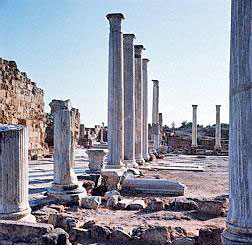
When Greece
rose to power, and after Darius tried in vain to conquer
them, Xerxes also failes at Salamis. Some Ruins of
Salamis, today Cyprus |
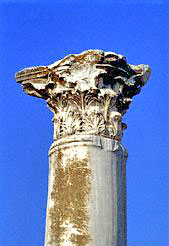
|
|
ONE HUNDRED
YEARS LATER.... THE BATTLES OF ALEXANDER ENSUED....
A BLOODY
CAMPAIGN WHICH REACHED INDIA TOO
|
|
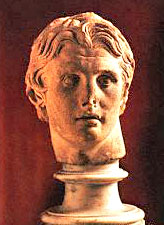 |
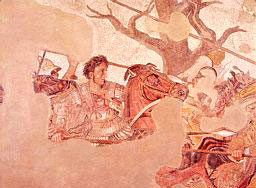
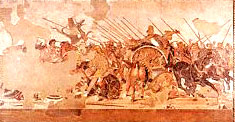 |
Return
Chapter Two
THE CONTENDING OF
HORUS AND SETH
"Was it a sad commentary on the history of warfare that the
messianic Essenes envisioned the Final War of Men as one in which
the Company of the Divine would join the Congregation of the
Mortals, and the "war cries of gods and men" would mingle on the
battlefield?
"Not at all. What The War of the Sons of Light against the Sons of
Darkness had envisioned was simply that human warfare shall end just
as it had begun: with gods and men fighting side by side.
"Incredible as it may sound, a document exists that describes the
first war in which the gods involved mortal men. It is an
inscription on the walls of the great temple at Edfu, an ancient
Egyptian holy city that was dedicated to the god Horus.
"....The inscription, remarkable for its geographical accuracy,
begins with an exact date - a date not in the affairs of men but of
the gods. It deals with events when the gods themselves, long before
the Pharaohs, reigned over Egypt:
"In the year 363 His Majesty,
Ra, the Holy One, the Falcon of the
Horizon, the Immortal Who For Ever Lives, was in the land of
Khenn.
He was accompanied by his warriors, for the enemies had conspired
against their lord in the district which has been called Ua-Ua
since that day...."
"....With a few words the ancient scribe succeeded in drawing the
background as well as setting the stage for the unusual war that was
about to unfold. We gather at once that the battle was brought on by
a conspiracy by certain "enemies" of the gods Ra and
Horus, to take
away the "Luminous Crown of Lordship" unto themselves. This,
obviously, could have been done only by some other god or gods. To
forestall the conspiracy Ra - "accompanied by his warriors" - went
in his boat to a district where Horus had set up his headquarters.
"The "boat" of Ra, as is known from many other texts, was a
Celestial Boat in which Ra could soar to the farthest heavens. In
this instance Ra used it to land far away from any waters, "in the
western part" of the district of Ua-Ua. There he landed east of the
"Throne Place" of Horus. And Horus came to greet his forefather and
respond to him that "the enemy" was gathering its forces.
"Then Ra, the Holy One, the Falcon of the Horizon, said unto
Horus,
the Winged Measurer: "Lofty issue of Ra, my begotten: Go quickly,
knock down the enemy whom you have seen."
"So instructed,
Horus took off in the Winged Disk to search for the
enemy from the skies.
"From the skies, flying in the
Winged Disk, Horus spotted the enemy
forces and unleashed upon them a "storm" that could neither be seen
nor heard, yet it brought instantaneous death.
"Horus then flew back to the
boat of Ra in the Winged Disk, "which
shined in many colours."
"....And Thoth (the god of magical
crafts) said:
"Oh Lord of the Gods! The
Winged Measurer has returned in the great
Winged Disk, shining with many colours...."
"Therefore he is named from that day on: "The Winged Measurer." And
they named after Horus the Winged Measurer, the city of
Hut "Behutet,"
from that day on.
"....Traditions held that Edfu was where
Horus established a divine
metal foundry, at which unique weapons made of "divine iron" were
forged. It was there, too, that Horus trained an army of mesniu -
"Metal People." They were depicted on the walls of the temple of
Edfu as men with shaven heads, wearing a short tunic and a deep
collar, carrying weapons in each hand. A depiction of an
unidentified, harpoonlike weapon was included in the hieroglyphic
words for "divine iron" and "metal people."
"The mesniu were, according to Egyptian traditions, the
first men
ever to have been armed by the gods with weapons made of metal. They
also were, as we shall soon gather from the unfolding tale, the
first men to have been enlisted by a god to fight in the wars
between the gods.
"....The initial victories apparently also
strengthened the alliance
of the gods, for we are told that the Asiatic goddess Ishtar (the
Egyptian texts call her by her Canaanite name Ashtoreth) had joined
the group. Hovering in the sky, Horus called on Ra to scout the land
below.
"....Since the enemies on the land were hidden,
Ra had an idea: "And
Ra said unto the gods accompanying him: ’Let us guide our vessel
towards the water, for the enemy lies in the land.’ And they called
the waters ’The Travelled Waters’ from that day on." While
Ra could
utilize the amphibious capabilities of his vehicle, Horus was in
need of a waterborne vessel. So they gave him a boat, "and called it
Mak-A (Great Protector) unto this day."
It was then that the
first battle involving mortal men ensued.
"It was then that the
Winged Disk was adopted as the emblem of Horus
victorious:
"It is from that day that the metal emblems of
Horus have existed.
It was Horus who had fashioned as his emblem the Winged Disk,
placing it upon the forepart of the boat of Ra.
The goddess of the north and the goddess of the south, represented
as two serpents, he placed alongside.
"And Horus stood behind the emblem, upon the
boat of Ra, the Divine
Iron and the chain in his had.
"In spite of the proclamation of
Horus by Thoth as a bringer of
peace, peace was not yet in hand.
"....While the first aerial battle broke through the defenses
separating Egypt from Nubia at Syene (Aswan), the ensuing battles on
land and water secured for Horus the bend of the Nile, from
Thebes
to Dendera. There great temples and royal sites proliferated in days
to come. Now the way was open into the heartland of Egypt.... A
series of brief, but fierce, encounters then ensued; the place names
- well established in ancient Egyptian geography - indicate that the
attacking gods reached the area of lakes that had stretched in
antiquity from the Red Sea to the Mediterranean (some of which still
remain).
"....The Edfu temple inscription now shifts to a new panel, for
indeed there began a new chapter in that War of the Gods. The
enemies that had managed to escape "directed themselves by the Lake
of the North, setting themselves toward the Mediterranean, which
they desired to reach by sailing through the water district. But the
god smote their hearts (with fear), and when they reached the middle
of the waters as they fled, they directed themselves from the
western lake to the waters which connect with the lakes of the
district Mer, in order to join themselves there with the enemies who
were the Land of Seth."
"These verses provide not only geographical information; they also
identify "the enemies" for the first time.
It was when Horus, in hot pursuit, crossed the waters into the
territory of Seth that:
"It was then,
according to the inscription in the great temple of Edfu, that
Seth was so enraged that he faced Horus for a series of
battles - on the ground and in the air - for god-to-god combat. Of
this combat there have been found several versions.... What is
interesting at this point is the fact brought out by E.A. Wallis
Budge in The Gods of the Egyptians: that in the first involvement of
men in the Wars of the Gods, it was the arming of mankind with the
Divine Iron that brought victory to Horus:
"It is pretty clear that
he owed his success chiefly to the superiority of the weapons with
which he and his men were armed, and to the material of which they
were made."
"Thus according to Egyptian writings, did man learn to lift sword
against man.
"When all the fighting was over, Ra expressed satisfaction with the
works of "these Metal People of Horus," and he decreed that
henceforth they "shall dwell in sanctuaries" and shall be served
with libations and offerings "as their reward, because they have
slain the enemies of the god Horus." They were settled at
Edfu, the
Upper Egypt capital of Horus, and in This (Tanis in Greek, the
biblical Zo’an), the Lower Egypt capital of the god. In time they
outgrew their purely military role and attained the title Shamsu-Hor
("Attendants of Horus"), serving as his human aides and emissaries.
"The inscriptions on the
temple walls at Edfu, it has been established, was a copy of a text
that was known to the Egyptian scribes from earlier sources but when
and by whom the original text had been composed, no one can really
tell....
"....As with all Egyptian historical texts, this one, too, begins
with a date: "In the year 363." Such dates always indicate the
year
in the reign of the Pharaoh to whom the event pertains: each Pharaoh
had his first year, second year, and so on. The text in question,
however, deals not with the affair of kings but with divine matters
- a war among the gods. The text thus relates events that had
happened in the "year 363" in the reign of certain gods and takes us
back to the early times when gods, not men,
ruled over Egypt.
"Thus there indeed had been such a time, Egyptian traditions left no
doubt. The Greek historian Herodotus (fifth century B.C.), on his
extensive visit to Egypt, was given by the priests details of the Pharaonic dynasties and reigns. "The priests," he wrote, "said that
Men was the first king of Egypt, and that it was he who raised the
dyke which protects Memphis from the inundations of the Nile,"
diverted the river, and proceeded to build Memphis on the reclaimed
land. "Besides these works he also, the priests said, built the
temple of Vulcan, which stands within the city, a vast edifice, very
worthy of mention.
"Next day read me from a papyrus the names of 330 monarchs who were
his successors upon the throne. In this number of successors there
were eighteen Ethiopian kings, and one queen who was a native, all
the rest were kings and Egyptians."
"The priests then showed
Herodotus rows of statues representing the
successive Pharaohs and related to him various details pertaining to
some of those kings and their claims to divine ancestry.
"The beings represented by these images were very far indeed from
being gods," Herodotus commented; "however," he went on to say:
"In times preceding them it was otherwise: Then
Egypt had gods for
its rulers, who dwelt upon the Earth with men, one of them being
always supreme above the rest. The last of this was Horus, the son of
Osiris, whom the Greeks
called Apollo. He deposed Typhon, and ruled over Egypt as its
last
god-king."
"....Manetho, (an Egyptian priest) (according to
Flavius Josephus)
was the first known historian to have divided the Egyptian rulers
into dynasties - a practice continued to this day. His Kings List -
names, lengths of reign, order of succession, and some other
pertinent information - has been mainly preserved through the
writings of Julius Africanus and Eusebius Caesarea (in the third and
fourth centuries A.D.).
These and other versions based on Manetho agree that he listed as
the first ruler of this first dynasty of Pharaohs the king Men (Menes
in Greek) - the very same king that Herodotus reported, based on his
own investigations in Egypt.
"This fact has since been confirmed by modern discoveries, such as
the Tablets of Abydos in which the Pharaoh Seti I, accompanied by
his son, Ramses II, listed the names of seventy-five of his
predecessors. The first one to be named is Mena.
"If
Herodotus is correct in regard to the dynasties of Egyptian
Pharaohs, could he also have been right in regard to a "preceding
time" when "Egypt had gods for its rulers"?
"Manetho, we find, had agreed with Herodotus also on that matter.
The dynasties of the Pharaohs, he wrote, were preceded by four other
dynasties - two of gods, one of demigods, and a
transitional
dynasty.
Seven gods completing 12,300 years as
Manetho indicated:
"Ptah, Ra, Shu, Geb, Osiris, Seth, Horus" = 12,300 years.
Mr. Sitchin presents a table with different amount of years for each
god.
"....A century and a half of archaeological discoveries and the
deciphering of the hieroglyphic writing have convinced scholars that
the Pharaonic dynasties probably began in Egypt circa 3100 B.C.;
indeed, under a ruler whose hieroglyph, reads Men. He united Upper
and Lower Egypt and established his capital at a new city called
Men-Neter ("The Beauty of Men") - Memphis in Greek.
"....A major archaeological document dealing with Egyptian kingship,
the so-called Turin Papyrus, begins with a dynasty of gods that list
Ra, Geb, Osiris, Seth, and Horus, then
Thoth, Maat, and others, and
assigns to Horus - just as Manetho did - a reign of 300 years. This
papyrus, which dates from the time of Ramses II, lists
after the
divine rulers thirty-eight semidivine rulers: Nineteen Chiefs of the
White Wall and nineteen Venerables of the North." Between them and
Menes, the Turin Payrus states, there ruled human kings under the
patronage of Horus, their epithet was Shamsu-Hor!
"Addressing the Royal Society of Literature in London in 1843, the
curator of Egyptian Antiquities at the British Museum, Dr. Samuel
Birch, announced that he had counted on the papyrus and its
fragments a total of 330 names - a number that "coincided with the
300 kings mentioned by Herodotus."
"....The Egyptians believed that "a very great god who came forth in
the earliest times" arrived in the land and found it lying under
water and mud. He undertook great works of dyking and land
reclamation, literally raising Egypt out of the waters - thus
explaining Egypt’s nickname "The Raised Land." This olden god was
named Ptah - a "God of Heaven and Earth." He was considered to be a
great engineer and artificer.
"....Ptah and the other gods were called, in Egyptian,
Ntr -
"Guardian, Watcher." They had come to Egypt, the Egyptians wrote,
from Ta-Ur, the "Far/Foreign Land," whose name
Ur meant "olden" but
could have also been the actual place name - a place well known from
Mesopotamian and biblical records: the ancient city of Ur in
southern Mesopotamia. And the straits of the Red Sea, which
connected Mesopotamia and Egypt, were called Ta-Neter, the "Place of
the Gods," the passage by which they had come to Egypt.
"....In time - after 9,000 years, according to Manetho -
Ra, a son
of Ptah, became the ruler over Egypt. His name, too, had no meaning
in Egyptian, but because Ra was associated with a bright celestial
body, scholars assumed that Ra meant "bright." We do know with
greater certainty that one of his nicknames, Tem, had the Semitic
connotation "the Complete, the Pure One."
"It was believed by the Egyptians that
Ra, too, had come to Earth
from the "Planet of Millions of Years" in a Celestial Barge, the
conical upper part of which, called Ben-Ben ("Pyramidion Bird"), was
later on preserved in a specially built shrine in the sacred city Anu (the biblical
On, which is better known by its Greek name Heliopolis).
"....The first divine couple to rule when
Ra tired of staying in
Egypt were his own children, the male Shu ("Dryness") and the female
Tefnut ("Moisture"), their main task, according to Egyptian tales,
was to help Ra control the skies over the Earth.
"Shu and
Tefnut set the example for mortal Pharaohs in later times:
the king selected his own half-sister as his royal spouse. They were
followed on the divine throne - as both legends and Manetho inform
us - by their children, again a brother-sister couple: Geb ("Who
piles up the Earth") and Nut ("The Stretched-out Firmament").
"....Geb and Nut turned over the direct rule of Egypt to their four
children: Asar ("The All-Seeing"), whom the Greeks called
Osiris,
and his sister-wife Ast, better known as Isis; and Seth and his wife
Nephtys (Nebt-Hat, "Lady of the House"), the sister of
Isis. It was
with these gods, who were truly gods of Egypt, that the Egyptian
tales most concerned themselves, but in depicting them Seth
was
never shown without his animal disguise: his face was never seen,
and the meaning of his name still defies Egyptologists, even if it
is identical to the name given in the Bible to Adam and Eve’s third
son.
"Osiris was given the
northern lowlands (Lower Egypt), and Seth was given the southern,
mountainous part (Upper Egypt). How long this arrangement lasted we
can only guess from Manetho’s chronicles; but it is certain that
Seth was not satisfied with the divisions of sovereignty and
resorted to various schemes to gain control over the whole of Egypt.
Mr. Sitchin explains at this point in his book, the various
hereditary rules for ascending to the throne having, it seems, the
great Ra himself fathering some of Nut’s children instead of
Geb,
but Seth was definitely a son of Geb and Geb’s half sister
Nut, so
in fact he was the legitimate inheritor, even if Osiris was fathered
by the great Ra. And this was Seth’s claim.
Mr. Sitchin also gives
The Book of the Dead, as a reference where
one may find all the legends of this period of time, when Seth
killed Osiris, his brother.
"....Since all seemed to believe that
Osiris had perished without
leaving a heir, Seth saw this as his chance to obtain a legitimate
heir by forcing Isis to espouse him. He kidnapped her and held her
prisoner until she consented. But with the aid of the god Thoth,
Isis managed to escape. A version recorded on the so-called
Metternich Stela, composed as a tale by Isis in her own words,
describes her escape in the night and her adventures until she
reached the swamps where Horus was hidden. She found Horus dying
from a scorpion’s sting. One can infer from the text that it was
word of his son’s dying that prompted her escape. The people who
lived in the swamps came out at her cries but were helpless to be of
any aid. Then help came from a spacecraft:
"Then Isis sent forth a cry to heaven and addressed her appeal to
the Boat of Millions of Years.
And the Celestial Disk
stood still, and moved not from the place it
was. And Thoth came down, and he was provided with magical powers, and
possessed the great power which made the word become indeed. And he
said:
"Oh Isis, thou goddess, thou glorious one, who has knowledge of the
mouth; behold, no evil shall come upon the child Horus, for his
protection cometh from the Boat of Ra.
"I have come this day in the Boat of the Celestial Disk, from the
place where it was yesterday. When the night cometh, this Light
shall drive away [the poison] for the healing of Horus. . .
"I have come from the skies to save the child for his mother."
"Revived from death by the artful
Thoth, some texts say immunized
forever as a result of Thoth’s treatment, Horus grew up as
Netch-atef, "Avenger of his Father."
Eventually, Horus appeared before the Council of the Gods to claim
the throne of Osiris.
"....According to the
Edfu temple inscription, the first
face-to-face battle between Horus and Seth took place a the "Lake of
the Gods," thereafter known as the "Lake of Battle."
Horus managed
to hit Seth with his Divine Lance; when Seth fell down,
Horus
captured him and brought him before Ra.... who decided that
Isis and Horus could do with Seth and the other captured "conspirators" as
they pleased.
Although there are several versions of what ensued, the fact is that
Seth managed to escape.
"....After his escape
Seth at first hid in a subterranean tunnel.
After a lull of six days, a series of aerial battle ensued. Horus
took to the air in a Nar (a "Fiery Pillar"), which was depicted as
an elongated, cylindrical vessel equipped with fins or short wings.
Its bulkhead contained two "eyes," which kept changing color from
blue to red and back to blue; from the rear, jetlike trails were
shown; from the front, the contraption spewed out rays.
"(The Egyptian texts, all written by the followers of
Horus, contain
no descriptions of Seth’s aerial vehicle).
"The texts describe a battle that ranged far and wide, and the first
to be hit was Horus - struck by a bolt of light from Seth’s vehicle.
The Nar lost one of its "eyes," and Horus continued the fight from
the Winged Disk of Ra. From out of this he shot a "harpoon" at
Seth,
now Seth was hit, and lost his testicles. . .
"Dwelling on the nature of the weapon,
W. Max Muller wrote in
Egyptian Mythology that it had "a strange, practically impossible
head" and was nicknamed in the hieroglyphic texts "the weapon of
thirty." As ancient depictions reveal, "the harpoon" was indeed an
ingenious three-in-one rocket: as the first, larger missile was
fired, the way was opened for the two smaller missiles to be
launched.
"The nickname ("Weapon of Thirty") suggests that the missiles were
what we nowadays call Multiple Warhead Missiles, each missile
holding ten warheads.
"Through sheer coincidence, but probably because similar
circumstance result in similar connotations, the McDonnell Douglas
Corporation of St. Louis, Missouri, has named its newly developed
naval guided missile "The Harpoon."
"The great gods called a truce and once again summoned the
adversaries before the Council of the Gods. We glean details from
the deliberations from a text inscribed on a stone column by the
Pharaoh Shabako (eighth century B.C.), who stated that the text is a
copy made from a very old leather scroll, "devoured by worms," which
was found buried in the great temple of Ptah at Memphis. The
Council, at first, redivided Egypt between Horus and Seth, along the
lines of the divisions at the time of Osiris, but Geb had second
thoughts and upset the decision, for he was concerned with the
question of continuity: Who would, "open the body" to successive
generations? Seth, having lost his testicles, could no longer have
offspring.... And so Geb, "Lord Earth, gave as a heritage to
Horus"
the whole of Egypt. To Seth a dominion away from Egypt was to be
given; henceforth, he was deemed by the Egyptians to have become an
Asiatic deity.
"The Council of the Gods accepted the recommendations unanimously.
Its final action is thus described in the Papyrus of Hunefer:
"Horus is triumphant in the presence of the whole company of the
gods. The sovereignty over the world hath been given unto him, and
his dominion is in the uttermost parts of Earth.
"The throne of the god
Geb had been adjudged unto him, along with
the rank which hath been founded by the god Shu.
"The legitimation, the
Papyrus went to say:
""Hath been formalized by decrees [lodged] in the Chamber of
Records; It hath been inscribed upon a metal tablet according to the
commandments of thy father
Ptah....
Gods celestial and gods terrestrial transfer themselves to the
services of thy son Horus. They follow him to the Hall of Decrees.
He shall lord over them."
Return
Chapter Three
THE MISSILES OF ZEUS
AND INDRA
"....The Greek sources from which Herodotus could have drawn are,
fortunately, still available: various literary works, such as
Homer’s Iliad; the Odes of Pindar of Thebes, written and well known
just before Herodotus’ time; and first and foremost, the Theogony
("Divine Genealogy") by Hesiod, a native of Askara in central Greece
who composed this work and another (Works and Days) in the eighth
century B.C.
"....The tale of the gods as revealed to Hesiod was mostly one of
passion, revolt, cunning, and mutilation; as well as of struggles
and global wars. In spite of all the glorification to Zeus, there is
no apparent attempt to cover the chain of bloody violence that had
led to his supremacy. What ever the Muses sang on, Hesiod wrote
down: "and these things did sing the Muses, nine daughters begotten
of Zeus":
Verily, at first Chaos came to be,
and next the wide-bosomed Gaea . . .
And dim Tartarus, in the depths of wide-pathed Earth,
and Eros, fairest among the deathless gods . . .
From Chaos came forth Erebus and black Nyx,
And of Nyx were born Acher and Hemera.
"This first group of
celestial gods was completed when Gaea
("Earth") brought forth Uranus ("Starry Heaven") and then espoused
her firstborn son so that he might be included in the First Dynasty
of the gods. Besides Uranus, and soon after he was born, Gaea also
gave birth to his graceful sister, Uraea, and to "Pontus, the
fruitless Deep with his raging swell."
"Then the next generation of gods were born - offspring of
Gaea’s
mating with Uranus:
Oceanus, Cocus, Crius, Hyperion, Iapetus. Theia, Rhea, Themis,
Mnemosyne, Phoche, Thetys, Cronos.
"....In spite of the fact that these twelve were offspring of the
mating of a son with his own mother, the children - six males,
six
females - were worthy of their divine origins. But as Uranus got
lustier and lustier the offspring that followed - though formidable
in might - displayed various deformities. First of the "monsters" to
be born were the three Cyclopes, Brontes ("The Thunderer"),
Steropes
("The Maker of Lightning"), and Arges ("Who Makes
Radiation"); in all
else they were like the gods, but one eye only was set in the midst
of their foreheads; and they were named ’Orbeyed’ (Cyclopes) because
one orbed eye was set in their foreheads."
Three more sons were born to
Gaea and Uranus, Cottus, Briareus and Gyes.... "Of giant size, the three were called
Hekatoncheires ("The
Hundred-Armed"): "From their shoulders sprang an hundred arms, not
to be approached, and each had fifty heads, upon his shoulders."
"Cronos hated his lusty sire," Hesiod wrote; but "Uranus rejoiced in
his evil doing."
Eventually Gaea and
Cronos planned the castration of Uranus and they
succeeded.
"....But the castration of Uranus did not completely terminate his
line of offspring. As his blood gushed forth, some of the blood
drops impregnated Gaea, and she conceived and bore "the strong Erinyes" (female
Furies of vengeance) "and the great Gigantes with
gleaming armor, holding long spears in their hands; and the Nymphs
whom they call Meliae [’the Nymphs of the ash tree’]." Of the
castrated genitals, leaving a trail of foam as the surging sea
carried them to the island of Cyprus, "there came forth an awful and
lovely goddess.... gods and men call her Aphrodite [’She of the
Foam’]
"The incapacitated Uranus called out to the monster-gods for
vengeance. His own children, he cried out, had become Titans,
Strainers who had "strained and did presumptuously the dreadful
deed...."
".... All along, while Uranus was busy bringing forth his own
offspring, the other gods were also proliferating, their children
bore names indicating their attributes.... Nyx responded to his call
by bringing forth the deities of evil.... The call of Uranus has
been answered: fighting, battles, and war came to be among the gods.
"It was into this dangerous world that the Titans were bringing
forth their third generation of the gods. Fearful of retribution
(Nemesis), they kept closely to each other, five of the six brothers
espousing five of their own six sisters. Of this divine
brother-sisters couples, most important was that of Cronos and
Rhea,
for it was Cronos, by reason of his bold deed, who had assumed the
leadership among the gods. Of this union, Rhea gave birth to
three
daughters and three sons: Hestia, Demeter, and
Hera; and Hades,
Poseidon, and Zeus.
Mr. Sitchin at this stage delights the reader with several pages of
the history and battles of Zeus, from the records of the
Theogony,
mainly the battle with Typhon, the youngest son of Gaea. Mentioned
are also the involvement of all the other gods.
"....The similarity between the battles, the weapons used, the
locations, as well as the tales of castration, mutilation, and
resurrection - all in the course of the struggle for succession -
convinced Herodotus (and other Greek classical historians) that the
Greeks had borrowed their theogony from the Egyptians.
Aegipan stood
for the African Ram God of Egypt, and Hermes paralleled the
god Thoth. Hesiod himself reported that when Zeus came unto the mortal
beauty Alemena so that she might bear him the heroic Heracles, he
slipped at night from Mount Olympus and went to the land of Typhaonion, resting there atop the
Phikion (The Sphinx Mountain).
"The deadly Sphinx that destroyed the Cadmeans" ("The Ancients"),
which featured in the doings of Hera, the official spouse of
Zeus,
was also connected in these legends with Typhon and his domain. And
Apollodorus reported that when Typhon was born and grew to an
incredible size, the gods rushed to Egypt to take a look at the
awesome monster.
"Most scholars have held that Mount Casius, the site of the final
battle between Zeus and Typhon, was located near the mouth of the Orontes river in today’s
Syria. But as Otto Eissfeldt has shown in a
major study (Baal Zaphon, Zeus Kasios und der Durchgang der
Israelitten durches Meer), there was another mount called by that
name in antiquity - a promontory on the Serbonic Sealet that juts
out of the Sinai peninsula into the Mediterranean Sea. He suggested
that was the mount referred to in the legends.
"Once again, all one had to do was to trust the information given to
Herodotus in Egypt. Describing the land route from Phoenicia to
Egypt via Philistia (History, Book III, 5), he wrote that the Asian
lands "extend to Lake Serbonis, near the place where Mount Casius
juts out into the sea. Egypt begins at Lake Serbonis, where the tale
goes that Typhon hid himself."
"Once again,
Greek and Egyptian tales converged, with the Sinai
peninsula as the climax.
HOMER,
some of the
sources where Greek "gods" are found.
|
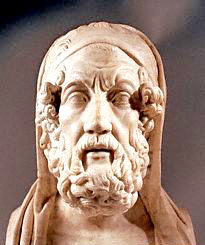
Homer |

Sarcophagus
sculpture from Homer’s Iliad
.
|
|
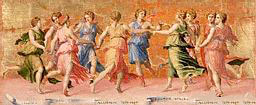
The "Muses,"
Zeus begotten daughters. |
|
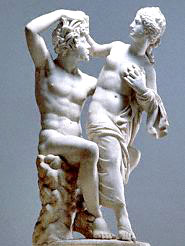
Nymphs, were
born to Uranus after his castration, when his blood
impregnated Gaea...
.
|
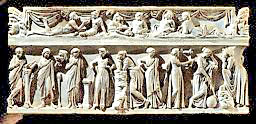
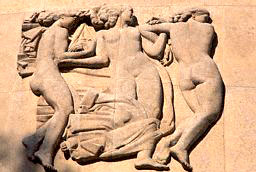 |
|
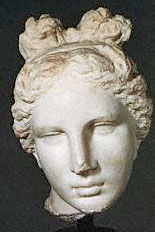 |
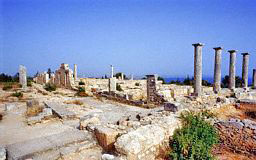
Classical
Greek Head of Aphrodite (left). Born in Cyprus, daughter
of Uranus. Sanctuary of Aphrodite, above, Cyprus.
|
|
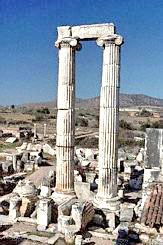 |
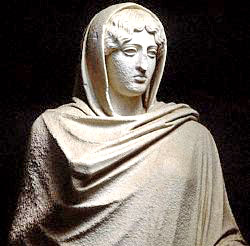
Roman statue
of Aphrodite |
|
Cronos had
become the leader of the "gods"
and to him and
Rhea were
born three daughters and three sons, some of them were:
|
|
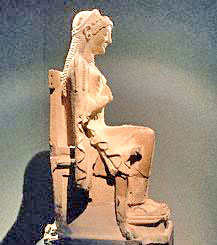
HERA, ruins
of her temples.
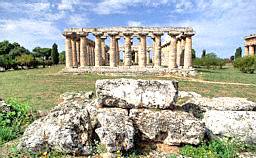 |
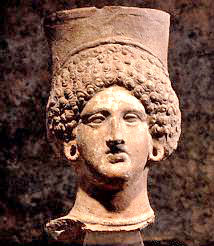
DEMETER
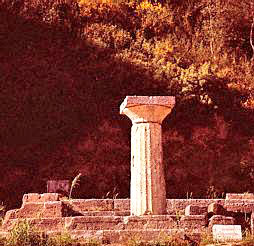 |
|
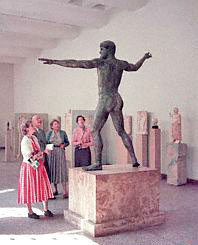 |
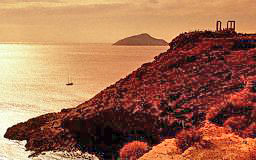
POSEIDON.
Cape Sounion, Greece, with remains of the temple of
Poseidon.
|
|
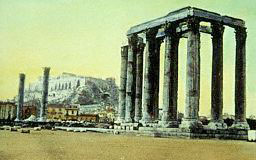
ZEUS. Temple
of Zeus in Athens. A sketch of Zeus on his Throne,
right.
|
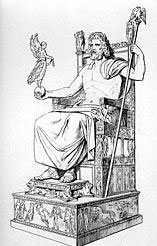 |
|
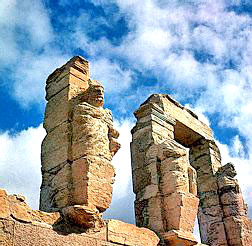
Stoa of
Hermes and Heracles, in Cyrene.
Heracles was a son of Zeus and Alemena. |
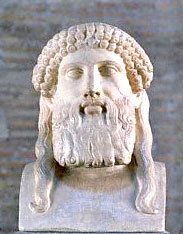
Roman Head
of Hermes
|
"Not withstanding the many connecting threads the ancient
Greeks had
found between their theogony and that of Egypt, it was much further
away - in India - that nineteenth-century European scholars have
found even more amazing parallels.
"No sooner had
Sanskrit, the language of ancient India, been
mastered at the end of the eighteenth century than Europe began to
be enchanted by translations of hitherto unknown writings. At first
a field dominated by the British, the study of Sanskrit literature,
philosophy and mythology was by the mid-nineteenth century a
favorite of German scholars, poets and intellectuals, for Sanskrit
turned out to be a mother language of the Indo-European languages
(to which German belonged), and its bearers to India were migrants
from the shores of the Caspian Sea - "Aryans," as the Germans
believed their ancestors, too, to have been.
"Central to this literature were
the Vedas, sacred scriptures
believed by Hindu tradition to be "not of human origin," having been
composed by the gods themselves in a previous age. They were brought
to the Indian subcontinent by the Aryan migrants sometime in the
second millennium B.C., as oral traditions. But as time went on,
more and more of the original 100,000 verses were lost; so, circa
200 B.C., a sage wrote the remaining verses, dividing them into four
parts: the Rig-Veda (the "Veda of Verses"), which is made up of ten
books;
-
the
Sama-Veda (the "Chanted Vedas")
-
the
Yajur-Veda (mostly
sacrificial praises)
-
the
Atharva-Veda (spells and
incantations
"In time, the various components of
the Vedas and the auxiliary
literature that stemmed from them (the Mantras, Brahmanas, Aranyakas,
Upanishads) were augmented by the non-Vedic Puranas ("Ancient
Writings"). Together with the great epic tales of the
Mahabarata and
Ramayana, they make up the sources of the Aryan and Hindu tales of
Heaven and Earth, gods and heroes.
"Because of the long oral interval, the length and profusion of
texts finally written down over many centuries, the many names,
generic terms, and epithets employed for the deities interchangeably
- and the fact that many of these original names and terms were
non-Aryan after all - consistency and precision are not hallmarks of
this Sanskrit literature. Yet some facts and events emerge as basic
tenets of the Aryan-Hindu legacy.
At this stage Mr. Sitchin gives the nomenclature of the beginning
"The Primeval Ones Who Flow," followed by the many gods, down to the
prolific Kasyapa, who by his consort Aditi were born to him seven
children at first, they were called the Adityas, they were seven at
first: Vishnu, Varuna, Mitra, Rudra, Pushan, Tvashtri, and Indra.
Then the Aditis were joined by Agni.
"....As in the Greek Olympian Circle, the number of
the Aditis
finally rose to twelve."
Among them were Bhaga.... and
Surya.
"Tvashtri ("Fashioner"), in his role as "All Accomplishing," the
artisan of the gods, provided them with aerial cars and magical
weapons. From a blazing celestial metal he fashioned a discus for
Vishnu, a trident for Rudra, a "fire weapon" for
Agni, a
"bolt-hurling Thunderer" for Indra, and a "flying mace" for
Surya.
In ancient Hindu depictions, all these weapons appeared as hand-held
missiles of diverse shapes. In addition, the gods acquired other
weapons from Tvashtri’ assistants; Indra, for example, obtained an,
"aerial net" with which he could snare his foes during sky battles.
"The celestial chariots or "aerial cars" were invariably described
as bright and radiant, made of or plated with gold. Indra’s
Vimana
(aerial car) had lights shining at its sides and moved "swifter than
thought," traversing rapidly vast distances. Its unseen steeds were
"Sun-eyed" emitting a reddish hue but also changing colors. In other
instances the aerial cars of the gods were described as multitiered;
sometimes they could not only fly in the air, but also travel under
water.
"....The texts also speak of the Ashvins ("Drivers"),
gods who
specialized in piloting aerial chariots. "Swift as young falcons,"
they were "the best of charioteers who reach the heavens," always
piloting their craft in pairs, accompanied by a navigator. Their
vehicles, which sometimes appeared in groups, were golden-made,
"bright and radiant . . .with easy seat and lightly rolling." They
were constructed on a triple principle, having three levels, three
seats, three supporting poles, and three rotating wheels.
"....The rotating wheels, it appears, served diverse functions: one
to raise the craft, another to give it direction, the third to speed
it along.
"As in the Greek tales, so did the gods of
the Vedas display little
morality or restraint in sexual matters - sometimes getting away
with it, sometimes not, as when the indignant Adityas selected
Rudra
("The Three-Eyed") to kill their grandfather Dyaus for having
violated their sister Ushas. (Dyaus, wounded, saved his life by
fleeing to a distant celestial body.) Also as in the Greek tales, so
did the gods according to Hindu lore mingle, in later times, in the
love and wars of mortal kings and heroes. In this instance the
aerial vehicles of the gods played roles even greater than their
weapons. Thus, when one hero drowned, the Ashvins appeared in a
fleet of three aerial chariots, "self-activated watertight ships
which traverse the air," dived into the ocean, retrieved the hero
from the water depths, and "conveyed him over land, beyond the
liquid ocean."
"....As in the Iliad, so did Hindu traditions tell of war of men and
gods over beautiful heroines. Best known of these tales is the
Ramayana, the long epic of Rama the prince whose beautiful wife was
abducted by the king of Lanka (the island of Ceylon, off India).
"....But that was yet in times to come; in the olden days
the gods
battled among themselves for more important causes: supremacy and
rule over the Earth and its resources. With so many offspring of
Kasyapa by diverse wives and concubines, as well as the descendants
of the other gods, conflict soon became inevitable. The dominance of
the Adityas was especially resented by the Asuras, elder gods whose
mothers bore them to Kasyapa before the Adityas were born. Bearing a
non-Aryan name of a clear Near Eastern origin (being akin to names
of the supreme gods of Assyria, Babylon, and Egypt - Ashur,
Asur,
Osiris), they eventually assumed in the Hindu traditions the
role of
the evil gods, the "demons."
"Jealousy, rivalry, and other causes of friction finally led to war
when the Earth, "which at first produced food without cultivation,"
succumbed to a global famine. The gods, the texts reveal, sustained
their immortality by drinking Soma, an ambrosiac that was brought
down to Earth from the Celestial Abode by an eagle and it was drunk
mixed with milk. The "kine" ("cow-cattle") also provided the gods’
favored "sacrifices" of roasted meat. But the time came when all
these necessities became scarcer and scarcer.
"....wars were fought on land, in the air, and beneath the seas."
"....One who excelled in these battles was Indra ("Storm"). On land
he smote ninety-nine strongholds of the Asuras, killing great
numbers of their followers. In the skies he fought from his aerial
car the Asuras, who were hiding in their "cloud fortresses." Hymns
in the Rig-Veda, list groups of gods as well as individual deities
defeated by Indra.
"....Defeating the gods’ enemies in groups as well, as in single
combat, and making them "flee to destruction," Indra turned his
efforts to the freeing of the kine. The "demons" hid them inside a
mountain, guarded by Vala ("Encircler"); Indra, aided by the
Angirases, young gods who could emit divine flames, smashed into the
fortified hideaway and freed the kine. (Some scholars, as J. Herbert
in Hindu Mythology, hold that what Indra released or retrieved was a
Divine Ray, not cows, for the Sanskrit word go has both meanings.)
"When these wars of the gods began, the Adityas named
Agni ("Agile")
as Hotri, their "Chief of Office." As the wars progressed - some
texts suggest for well over a thousand years - Vishnu ("Active") was
made the Chief. But when the fighting was over, Indra, having
contributed so much to the victory, claimed the supremacy. As in the
Greek Theogony, one of his first acts to establish his claim was to
slay his own father. The Rig-Veda (Book iv: 18, 12) asks
Indra
rhetorically: "Indra, who made my mother a widow....?
"....For this crime
Indra was excluded by the gods from the drinking
of the Soma, therefore endangering his continued immortality. They
"ascended up to Heaven," leaving Indra with the kine he had
retrieved. But "he went up after them, with the raised
Thunder-weapon," ascending from the northern place of the gods.
Fearing his weapon, the gods shouted: "Do not hurl!" and agreed to
let Indra share once again in the divine nourishments.
But more battles ensued, as
Indra’ supremacy did not remained
unchallenged. The reason was as usual: succession. But Indra once
more achieved victory, this time over Tvashtri, although it was
Vitra who took the battle in place of Tvashtri.
This time:
"....Indra’s victory was complete; but as Fate would have it, the
fruits of victory were not his alone. As he was claiming the throne
of Kasyapa, his father, old doubts surfaced concerning his true
parenthood. It was a fact that upon his birth his mother had hid him
from Kasyapa’s wrath. Why? Was there truth to the rumors that
his
true father was his own elder brother, Tvashtri?
"The Vedas lift the veil of mystery only partly. They tell, however,
that Indra, great god that he was, did not rule alone: he had to
share powers with Agni and Surya his brother - just as
Zeus had to
share dominions with his brothers Hades and Poseidon.
India
|
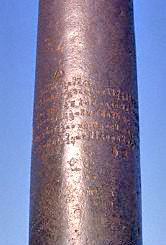
Ancient sanskrit scrypt on iron Gupta Pillar
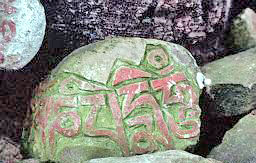
Stone with
inscribed "mantra"; this one from the Nepal area
|

The area of
the Caspian Sea, where Germans believed their ancestry
stemmed from. Therefore they became serious students of
the "Aryans" and the Vedas, as the Aryans were the
people who migrated to India
. |
|
EPICS: THE
MAHABARATA AND THE RAMAYANA |
|
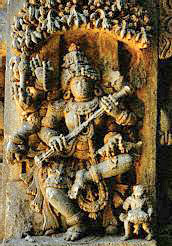
Two
depictions from the "Mahabarata";
right, Lord
Vishnu, posing as Krishna.
Above, Goddess of the Earth, Sarasvati.
Temple in
Somanthpur, India |
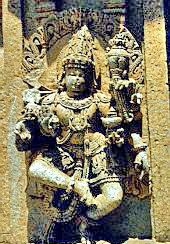
|
|
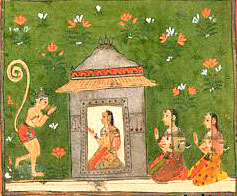
Hanuman, in front of Sita, Rama’s wife, who was
re-captured from a "demon god"
Scene from the Ramayana. |
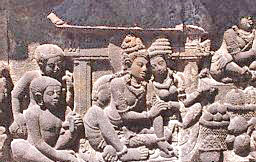
Rama and
Sita in the court of the Palace of King Dansara
.
|
|
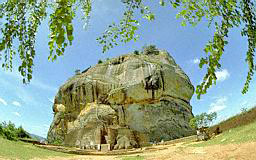
Lions
Terrace of Sigiriya. A ruined Fortress and Place of King
Kasyapa, Sri Lanka |
KASYAPA AND ADITI
had seven children, some of whom were:
|
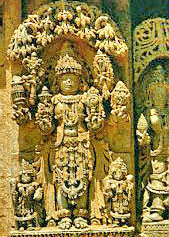
LORD VISHNU
|
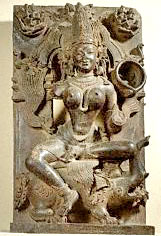
VARUNA,
Sculpture from Orissa |
|
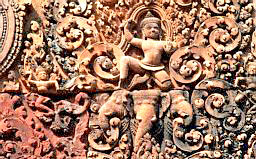
INDRA.
sculpture on a three headed elephant
.
|
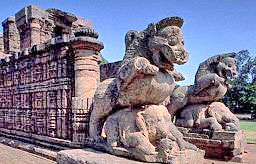
Three other
sons were added to Kasyapa, one of them was Surya, whose
Temple, left, shows "dragon horses mounting elephants,
simulating the pulling of the Temple toward east. |
|
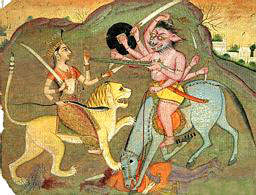
One of the
Great Battles between the Devas and the Asuras. This
depiction is the goddess Durga, (who is an incarnation
of God Vishnu’s anger and Shiva), fighting a "demon."
National Museum of New Delhi
.
|
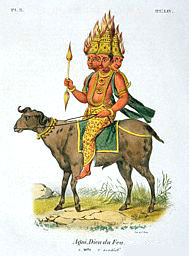
God Agni,
god of Fire.
He became the "Chief of Office" of the Adityas
|
Return
|



























































